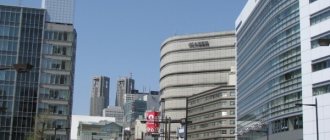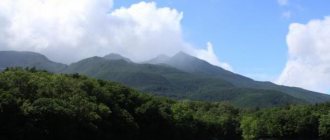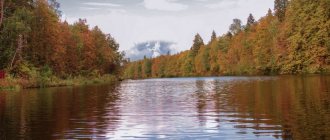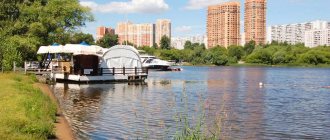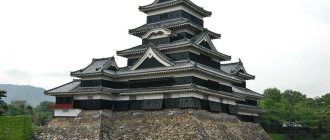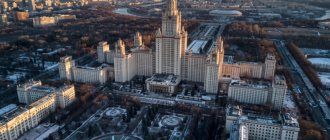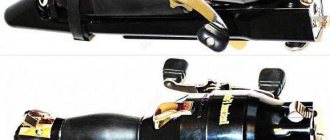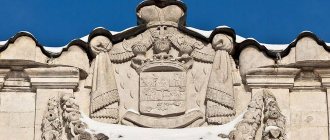Where is
Osaka, whose sights were badly damaged during the destruction of World War II, traces its history back to the 6th century, when the capital of Japan was located on its territory and the imperial palace was located. It was here that the main maritime trade route through the Sea of Japan and the land route connecting the mainland and western lands with the interior regions of the country crossed.
The city has not lost this leading position as the main shopping center throughout its history to the present day. The modern city is located on an area of 223 square meters. km on the Yodo River in the central part of Honshu Island in Osaka Bay with access to the Inland Sea.
The population of the 3rd largest city in Japan has more than 2.6 million inhabitants, and the density exceeds 12 thousand people per 1 sq. m. km.
The most convenient way to get to the city is by plane. There is an international airport here, but there are no direct flights from Moscow; you will have to make a transfer to Tokyo. Flight time can take from 11 to 45 hours. Without a transfer you can fly on 2 flights a week from Vladivostok. There is a second airport for domestic flights.
From other Japanese cities it is more convenient and easier to travel by high-speed train. In addition, this can be the most profitable, since there is a convenient system of train tickets.
| From the locality to Osaka | Travel time. | Fare in yen |
| Tokyo | 2.5 hours | 14.5 thousand |
| Kyoto | from 13 to 25 min. | from 560 to 3 thousand |
| Port of Kobe | from 12 to 30 min. | from 640 to 3.1 thousand |
A little history
Osaka is a historically interesting city. The history of its origin goes back to the 4th century, when Emperor Jimmu landed on the island and formed a city on its shores. The development of Osaka occurred gradually in a given direction, and in the 16th century the city was strengthened by the construction of fortresses and forts. An interesting fact is that the then reigning Emperor Toyotomi Hideyoshi forced merchant merchants to move to the city from Kyoto. This was due to his desire to turn Osaka into the center of trade for all of Japan. At the same time, military battles were taking place on the territory of Osaka to establish dominance. Merchants living in Osaka actively directed their funds to support various artists and other representatives of the cultural movement. With their support, outstanding masterpieces of painting were created, which are kept to this day in many museums around the world. Many paintings and canvases of that period reflect the period of decline of the city, the departure from traditional foundations and provisions. Artists noted the lack of special principles and directions of development among the samurai of that historical period. But, despite these negative trends in the development of the city, industry and trade continued to flourish. Therefore, the number of inhabitants grew steadily and after World War II amounted to 3.5 million.
Weather, best time to travel
Osaka, whose attractions are among the most visited places in Japan, is located in a subtropical humid climate zone influenced by the Sea of Japan.
The area is characterized by long, hot summers, when the air warms up to +30°C and above. Warm, sunny autumn gives way to a short winter snowless period with an average air temperature of about +7°C +13°C.
Precipitation in the form of snow is very rare, and there is little rain in the winter months. The greatest number of showers occurs in the summer months and September. Western or northeastern winds blow constantly throughout the year.
The city is transformed in spring at the end of March and beginning of April, when the most magical period of cherry blossoms begins. At this time, there is usually a tourist boom, prices for food and housing rise to the maximum.
Climb to heights
Where: Abeno Harukas
The Abeno Harukas skyscraper is the tallest not only in Osaka, but throughout Japan. Arrive half an hour before sunset, go up to the observation deck on the 60th floor and forget about everything, admiring the breathtaking views of the evening metropolis. When you come to your senses, settle into the glass-walled cafe on 58th: no activity in Osaka will be completely satisfying without delicious food.
By spring 2021, the Abeno Harukas skyscraper promises to again launch extreme entertainment - a walk along the edge. At the very top of the building, in the open air and without any glass, there are walkways on which you can walk and feel like a base jumper before jumping - with insurance, of course.
Another cool observation deck in Osaka is at the futuristic Umeda Sky skyscraper, which consists of two towers connected at the top.
- Are you weak? The Most Scary Lookouts, Trails and Bridges on the Planet
Tickets to Osaka
Car rental in Osaka
Religious buildings
In a city with a distinctive culture, it will be interesting to visit and inspect the main religious buildings in order to better understand and get acquainted with the way of life of the local population.
Isshin-ji
The Buddhist temple of the urban district of Tennoji belongs to the Pure Land direction and is the oldest center of this school, which dates back to the beginning of the 12th century.
The name Isshin-ji translates as one heart. The temple complex was completely restored after the bombing of the middle of the last century. Today, here you can visit the Nembutsu-do and Hondo pavilions with Buddhist statues made from the ashes and ground bones of the dead, held together with a special resin.
Shitenno-ji
Another ancient Buddhist temple named after the 4 heavenly lords is located in the Tennoji region. Here you can see the Paradise, Great Southern and Middle Gates, a 5-tier pagoda, the Golden and Lecture Halls, a gallery and much more, reconstructed in concrete after the war.
All buildings are made in the same Korean-Chinese style, typical of the ancient Asuka culture. Every year in April a cremation ceremony takes place here.
Sumiyoshi-taisha
The Shinto temple complex is considered the main shrine of the god Sumiyoshi, where the oldest seals of Japan and the most ancient imperial regulations of the period of the XII-XIV centuries are kept. This sacred place is the birthplace of Heian culture and has enjoyed imperial patronage since ancient times. The sanctuary is dedicated to the gods, the patrons of shipping.
Today the complex is represented by 4 buildings, each of which is dedicated to a specific essence of the deity. From an architectural point of view, it represents a special style of sumyoshi-zukuri. The buildings are not connected to each other. The entire complex is surrounded by an araimi fence
Shitenno-ji Temple
Shitenno-ji is located in the Tenno-ji area of Osaka. It is one of the seven main temples built by Prince Shotoku. According to the Nihon Shoki chronicles compiled during the Nara period, the temple was built in 593 AD. - thus, the temple has more than 1400 years of history. Most of the buildings outside the temple walls were destroyed by fires and wars, but they have been carefully restored, maintaining the original design.
In the southern part of Shitenno-ji Temple there is a gate called Minamidaimon, and in the eastern part - Higashidaimon. The Isitoria Gate, recognized as an important cultural property, is located in the western part of the temple. After you pass through Isitorii, you will find yourself near the Gokurakumon Heaven Gate. Originally, the main gate of the temple was Minamidaimon, but many believers pass through Gokurakumon as it is believed to lead to heaven.
The main building of Shitenno-ji Temple is called Chushin Garan and is located just south of the center. In the northern part of Chushin Garan, right in the center of the temple, is Rokujiraisando, an important cultural property. Shoryoin (Taishiden), where Prince Shotoku rests, is located in the eastern part of Chushin Garan.
There are many other buildings on the temple grounds, including Mido, Ishibutai, as well as a cemetery, gardens, Homotsukan treasury, and so on. The temple area is quite spacious. If you are interested in ancient buildings and temples of Japan, we definitely recommend visiting this place.
The most interesting museums
Numerous museums in the city provide an opportunity to better learn the history and modern culture of the inhabitants of this country.
Museum of Oriental Ceramics
The museum's permanent collection features Japanese, Korean and Chinese ceramics from different eras, ranging from antiquity to the present day. The museum is open to visitors every day except Monday from 9:30 a.m. to 4:30 p.m. at 10-32 Amijimacho, Miyakojima-ku, Osaka 534-0026.
In addition to viewing the rich exhibition, you can go to the souvenir shop and purchase your favorite products from modern local craftsmen as souvenirs. The Ceramics Museum building is located on an island surrounded by a garden with an alley of luxurious roses along the embankment.
Museum of Housing and Living
An interesting museum introduces visitors to models of ancient Japanese cities and traditional residential buildings, the technology of building construction, the life of the ancient Japanese and cultural objects discovered during excavations. The museum is located at: 6-4-20 Tenjimbashi Kitaku | 8F, Osaka 530-0041. Open for free inspection any day of the week except Tuesday, from 10 a.m. to 5 p.m.
Fujita Art Museum
It contains a magnificent collection of Japanese and Chinese ancient paintings from the period of the 11th century, as well as a rich exhibition of antique objects of the tea ceremony, whose age exceeds 500 years. Open Tuesday through Sunday from 10 a.m. to 4 p.m., located at 10-32 Amijimacho, Miyakojima-ku, Osaka 534-0026. There is a magnificent garden around the museum building.
Osaka
Video: Osaka
general information
Business and pleasure are closely linked in Osaka, and have been for hundreds of years. Business reputation is a reflection of the city's history as a trading capital and major commercial center. When, after the unification of the country in 1583, Hideyoshi built his main castle in the center of Osaka, it seemed that its prosperity was guaranteed. With a free-spirited entrepreneurial class eager to spend their newfound wealth, Osaka quickly emerged as the nation's undisputed center for entertainment and theater. Despite the recession of the 1990s, a consequence of the bursting of the Japanese economic bubble, anyone strolling through the famous nightlife districts of central Osaka will quickly discover that the city's residents still love to eat, drink and be merry. Their adherence to the cult of food is defined by the term kuidare (depending on the interpretation, it means “eat until you drop” or “eat until you go broke”).
. Osaka may not win the competition for the most beautiful cities, but it does have a lot to offer, including several interesting museums, a remarkable aquarium, and what may be the world's largest underground shopping complex.
Panorama of Osaka
Osaka Subway
The best way to get around the city is the subway. Taxis are expensive and move at the pace of busy traffic, and information about bus routes that are indifferent to the needs of tourists is almost all in Japanese. Metro day pass (purchased at any ticket machine)
will cost less than four tickets within the central zone
(about £12)
.
Tourism information provision in Osaka is one of the best of any city in Japan. Information offices are scattered throughout the city, with the central one located at the Umeda train station. The best place to start exploring Osaka is in the bustling Umeda district, where in addition to the train station there are three metro stations and two private train stations. It is also home to some of the most famous department stores outside of Tokyo, giant buildings and the Hanshin, whose private railways link Osaka with Kyoto and Kobe. The Osaka Tourist Information Center is located just outside the main entrance to Hankyu Station. Umeda lies on the northern edge of the city's business and entertainment district, simply called Kita (North)
, and represents the quintessence of modern Osaka.
During rush hour, Umeda's crowded subway platforms are as crowded as the Tokyo subway. No less impressive are the crowds of people near Umeda, in a gigantic cluster of shops, bars and inexpensive stylish restaurants, the number of which is amazing. The base of every major building within a one-mile radius is connected to some kind of modern shopping labyrinth. In fact, several shopping centers are located underground, leading one into another, thereby maximizing the turnover of customers and cash. If you want to explore underground attractions, start at White Umeda under the buildings and Hanshin and head towards Herbis Plaza, but be aware that it won't be long before you see the light of day.
Umeda Sky Building
Skyscraper observation deck
Umeda Sky Building from below
The cure for a long stay underground is to climb the 40-story Umeda Sky Building. The futuristic structure, unusual in appearance, consists of two glass and steel towers connected to each other at the very top. There, visitors to the “Floating Observatory” can see a panoramic view of the city and the surrounding area.
Shopping arcades are a characteristic feature of any Japanese city and town. Not surprisingly, in Osaka they are the most impressive and may seem excessive to some. You might enjoy spending hours wandering around the Hankyu Hidashi-dori arcade near Hankyu Station, which is not as fancy but no less interesting than the more famous Shinsaibashi arcade. In the south of Kita, opposite the American consulate, lies Kita Shinchi, Osaka's main entertainment and gastronomic district centered on Shinchi Hondori Street. This is a great place for people watching, although only those with a hefty holiday budget will be able to eat here.
Near Kyobashi Station there is the Fujita Art Museum with an excellent collection of Chinese and Japanese paintings dating back to the 11th century. If you're a fan of the tea ceremony, check out the magnificent collection of 14th-century objects, including ceramic teacups, teapots and teapots, as well as bamboo spoons, whisks and flower vases. You can also admire ceramics at the Museum of Oriental Ceramics (Tue–Sun 9.30–17.00; www.moco.or.jp)
, surrounded by a garden at the tip of Nakanoshima, the “central island” in the middle of a wide river flowing through the center of Osaka. Here you can see excellent examples of the work of Korean and Chinese masters, whose influence largely shaped the unique style of Japanese ceramics. This is one of the best collections of its kind in the world with more than a thousand exhibits. Nakanoshima is home to most of Osaka's municipal buildings, including the elegant 1918 European-style City Hall, one of the few red brick buildings in Japan.
Osaka Castle
From here you will also have a wonderful view of Osaka Castle (daily 9.00-18.00, August 9.00-19.00; www.osaka.castle.net)
, beautifully illuminated in the evenings. Wanting to celebrate the unification of Japan after more than a hundred years of civil war, Hideyoshi turned his castle into the greatest fortress in the country, and then in 1615, after the deprivation of power of Hideyoshi's heir, the Tokugawa considered it their duty to destroy the castle. They later restored it to enhance their own prestige, but burned it again in a fit of irritation when their shogunate was abolished in 1868 during the Meiji Restoration. Today's concrete reconstruction reproduces only the majestic five-tiered tower, 42 m high, surrounded by moats and ivy-covered walls. The castle houses an interesting but depressingly modern museum exhibiting armor, weapons, costumes and historical documents. There is also a fascinating collection of bunraku dolls, providing a rare opportunity to see them up close.
Midosuji Boulevard
The greenery of the magnificent Midosuji Boulevard, lined with sycamores and ginkgo trees, provides a respite from the omnipresent asphalt. This highway extended south from Umeda to Kita's southern neighbor, Minami. On one side of the boulevard lies America-mura (“American Village”)
A favorite hangout for stylish urban youth, it gets its name from the large number of stores selling highly sought-after second-hand clothing from the United States.
One block east of Midosuji is the famous Shinsaibashi arcade, a shopping mecca second only to Tokyo's Ginza and Shinjuku. If you only have time for a single evening stroll in Osaka, go here. Although the arcade starts 1.6 km north, start your walk from Shinsaibashi Station Exit 6 on the Midosuji Subway Line, located between Sogo and Daimaru department stores, and turn right to head south. Every evening this area bustles with business-friendly nightclubs, girlie bars and private drinking clubs. By the way, many of the bars are strangely called “snack bars”, and tourists should be vigilant! These exotic establishments offer a glass of beer for £20, and in general the prices are aimed at single middle and senior managers with a hefty account, wanting to feel at home away from home. The area is home to fashionable youngsters looking for fun, as well as a growing colony of young foreign residents lured by the cheapness of the yen. On Sunday afternoons and evenings there is real pandemonium. An evening stroll along the side streets will allow you to plunge into the heady atmosphere of pleasure and commerce that has permeated this part of Osaka for centuries.
At the far southern end is the small Ebisu Bridge, better known as Hikkake-bashi, or "Dating Bridge", a popular meeting place for the city's hippest youth. Before you climb the bridge, on the left you will see an arch marking the beginning of Soemon-cho, a colorful street of nightlife restaurants and clubs, a kind of answer to Minamachi Kita-Shinchi near Umeda. Pay attention to the ultra-modern black and chrome beer hall “Kirin Plaza” located next to the arch.
Ebisu Bridge
View of Ebisu Bridge at night
Youth on the bridge
Stop at the bridge to soak in the sights and sounds of people, the glow of neon and the sight of the Dotomburi River beneath your feet. Hundreds of years ago, during Osaka's heyday as the capital of theater and entertainment, stage stars would sail by boat to the river-facing back entrances of the many theaters along Dotomburi Street just to the south. Enthusiastic admirers gathered on the old bridge that stood at the same place to look at their idols, who arrived in luxuriously decorated medieval analogues of modern limousines.
After the bridge, turning left, you will find yourself on Dotomburi, which in the evenings turns into the main irritant of the senses in Osaka. A host of strange creatures fill the facades of buildings and frame this open-air mall: giant monsters crawl down the walls of restaurants, cinemas, theaters, gaming centers and sensual noodle bars. No photographer is able to convey the energy of this strange and unforgettable combination of everything.
At the other end of Dotom Buri lies the territory of Nipponbashi with Den-Den-Town, a half-hearted attempt to give a fitting answer to Tokyo's Akihabara electronics district. Nipponbashi is also known as a nationwide center for bunraku, Japan's vibrant traditional puppet theater. Although various forms of puppet theater have been known since the 11th century, the expressive and elaborately costumed style of bunraku emerged by the 17th century. flourished equally in Osaka and Kyoto. Although its popularity declined during the Meiji period, it has been rediscovered in modern times, perhaps best demonstrated by the significant investment in the National Bunraku Theater in Nipponbashi. Bunraku is an extremely dramatic Japanese performance art that is well worth experiencing, even if only for an hour or so in the midst of a tense sightseeing chase. Although all dialogue and narration are conducted in Japanese, simultaneous translation devices or programs in English are always at your service.
Den Den Town
Electronics stores
Cosplayers on the streets of Nipponbashi
The Shin-Kabuki-za Theater located in the neighboring Namba district (at the end of Midosuji Boulevard)
gives performances only three weeks a year. However, other traditional forms of drama are widely represented, such as kyogen farces and manzai two-act comedies. Every spring, Osaka International Drama and Music Festival events take place at both the theater and the Festival Hall on Nakanoshima Island. Even if you don't get inside the latter, the architecture of the building itself is very impressive and worth seeing.
(Kitchen Street) between Nipponbashi and Namba areas.
— a narrow street of restaurant equipment suppliers. Here you can buy replicas of dishes that you see in restaurant windows as souvenirs, as well as Japanese-style plates, bowls, glasses, sake sets, lacquerware, giant paper lanterns and a million other things that you never expected to see on sale.
Tsutenkaku Tower
South of Namba, between Ebisucho and Tennoji stations, stands the Tsutenkaku Tower - a rather pathetic imitation of the Eiffel Tower (and perhaps the only structure that makes the tower in Kyoto look impressive)
.
The 90-meter height of the observation deck offers a panoramic view, but it is hardly worth the climb to the top. Nearby, next to Tennoji Station, the Osaka City Art Museum (Tue-Sun 9.30am-5pm; www.osaka-art-museum.jp)
is worth a visit for Abe's famous collection of 200 Chinese paintings from the 9th to 13th centuries.
and ceramics of the Ming and Qing dynasties of the XIV-XIX centuries. Keitakuen Garden (Tue-Sun 9.30-17.00)
as part of Tennoji Park, a vast green space with a huge greenhouse. A traditional Japanese garden with a pond in the center, Keitakuen is a gift from the wealthy owner of a trading company, one Baron Sumitomo. The presence of a large permanent homeless encampment around the park does not make the area look good, but it is quite safe there.
Nearby is Osaka's most famous temple, Shitennoji, founded in 593 by the revered reformer-lawmaker Prince Shotoku. Unfortunately, the buildings of this large temple complex are made of concrete copies of the originals, destroyed by bombing during the Second World War. Moreover, the massive stone torii gate, built in 1294, is the oldest in Japan. Shitennoji hosts Osaka's largest temple market on the 21st of every month, selling antiques, second-hand clothes and sundries. To the south is the Sumiyoshi Taisa Shrine, dedicated to the god of peace, song and navigation. The sanctuary's large, beautiful arched bridge is just one of its attractions, visited by 3 million devotees every year on the first three days of the New Year. Although the sanctuary is believed to have been founded in the 3rd century, the existing buildings are relatively recent constructions.
Shitennoji Temple
Located in the western part of the city, the port offers two ideal types of recreation for the whole family. In the bowels of the futuristic Kayukan Aquarium (daily 9.30–20.00; www.kaiyukan.com)
is home to one of the world's largest reservoirs with a stunning collection of sharks and other large deep-sea fish. It is surrounded by other containers in a downward spiral, introducing the inhabitants of the waters of the seismic zone of the Pacific Ring of Fire. The aquarium is part of an extensive complex of quaint shops and restaurants. This entire area is a great place for an afternoon break from other city attractions.
This once deserted part of the city has produced two interesting additions to the city's cultural and entertainment palette. The thought-provoking Osaka Human Rights Museum (Tue-Sun 10am-5pm; www.liberty.or.jp)
- a surprising phenomenon in a country that is often accused of refusing to discuss a number of pressing historical and social issues.
Quite different is the Universal Studios Japan amusement park (daily, hours vary; www.usj.co.jp/e/)
with attractions familiar to those who visited the original theme park, including simulators based on Jaws, " E.T. and Jurassic Park.
The nearby Maishima incineration plant may seem like an odd proposition for tourists, but the building, designed by Austrian artist and architect Friedrich Hundertwasser, is worth a look. The high-tech production is located in a surreal castle with turrets, terraced gardens and ceramic columns.
Monuments and Monuments
South of Namba rises the 100-meter Tsutenkaku television tower, which was erected in the middle of the last century on the site of one destroyed during the war. For a small fee you can go up to the observation deck.
The Osaka City Dorogenpyo Memorial Sign is located in the heart of the city at 1 Umeda, Kita-ku, Osaka 530-0001.
A very nice stylized Kitanosaurus statue can be found at the station at 1-3 Umeda Kita-ku JR Kitashinchi Station, Osaka 530-0001.
The monument to Ichizo Hayashi can be seen at 4 Kitahama, Chuo-ku, Osaka 541-0041.
Nakanoshima Park
Nakanoshima Park stretches between the Dojima and Tosabori rivers. Buildings line both sides of the park, radiating a. This park was a municipal park in Osaka for a long time and was opened in 1891. The total length of the park is 1.5 km, and the area is 106 thousand m2. It contains many old buildings, such as the Osaka Public Hall, opened in 1918, and the Osaka Library (now the Osaka Nakanoshima Prefectural Library).
During the Taisho Roman (a period of Japanese history around 1912-1926 that saw rapid cultural development), the Nakanoshima Rose Garden was planted in the middle of the park. From east to west it extends for 500 meters, and its total area is 13 thousand m2. There are 3,700 roses of 310 species, blooming from mid-May to mid-October, creating a beautiful, fragrant garden. Nakanoshima Park is a great place to relax after an exciting tour of Osaka.
Architectural structures
The main architectural landmark and symbol of the modern city is the 5-story samurai castle of the 16th century, which occupies an area of 1 sq. km on a high embankment of stone boulders, was intended for protection from sword-bearing warriors. The modern structure of the castle was restored at the end of the last century and is today open to visitors.
In addition to the central building with modern exhibitions of the history of Hideyoshi Toyatomi, it is worth visiting:
- Otemon Gate;
- Jaguar Towers;
- Defense ditches;
- Barracks for soldiers.
It is also worth visiting the panoramic platform on the 8th floor. The castle is open every day from 9 am to 5 pm, entrance tickets for adults are 600 yen, children under 15 years old visit the complex for free.
Osaka Castle
The main attraction of the city is the impressive Osaka Castle, the main part of which consists of 8 floors. He is a kind of symbol of the city. Osaka Castle was built in 1598. Its founder was the military leader Toyotomi Hideyoshi. There are exhibitions inside each floor. It is best to start your inspection from the top and gradually work your way down. To be more precise, this castle is a copy of the previous one, which was completely destroyed during the Second World War. Not far from the castle there is a park, Osakajo-Koen. This attraction will be interesting to visit both on your own and in the company of friends.
Natural attractions
In a modern industrial city there are many corners of unique nature that fit very harmoniously into the urban landscape.
- Magnificent Namba Park occupies 8 floors in the Parks Tower high-rise complex, representing original hanging gardens with living vegetation and artificial waterfalls among ponds.
- In Kaigana National Park you can see a large number of different caves, sand dunes and picturesque beaches. The eastern part of the highest waterfall, Tottori Falls, is also located here.
- Tennoji Zoo has been open for over a century. 1.5 thousand different animals and birds live here in natural conditions. The zoo's address is Tennoji Park, 1-108, Chausuyama-cho, Tennōji-ku, Osaka.
- The Kayukan Aquarium in the port part of the city is open to visitors every day from 9:30 to 20:00. It contains more than 11 thousand tons of water, you can see a huge number of different species of sharks and the largest deep-sea fish. The cost of visiting for adults is 2.3 thousand yen, for children from 7 to 15 years old the entrance ticket costs 1.2 thousand yen, children under 3 years old visit the aquarium for free. Tickets can be purchased in advance on the website. The modern building is built in the shape of a giant spiral with 14 levels. There are a large number of different cafes and restaurants around, and the world's largest Ferris wheel operates.
Intercity buses in Japan
We went to Shibuya and took a walk. We ate a couple of onigiri from konbini. And that's all. The heat and fatigue took their toll. Back to the hotel to get your suitcases, then to Shinjuku station, from where you walk to the Willer Express bus terminal.
It turned out that traveling on shinkansen is a luxury by the standards of ordinary Japanese.
While waiting for our bus, we got into conversation with Keito from Niigata. The guy clearly wanted to practice his English (oh, he could use the contacts of that homeless person!), but we were curious to informally communicate with one of the locals. It turned out that traveling on shinkansen is a luxury by the standards of ordinary Japanese. We told about our JR passes, ordered this time from the French. Traveling on buses and regular trains is a completely different matter. Here is the choice of an ordinary Japanese!
From my last trip to Japan, I still have a richly published booklet on Niigata in Russian. But, as is often the case with the Japanese, food was shown to be the basis of the region's tourist attraction. Also, I knew that the Russian consulate was located there. This is, perhaps, all the information about the city that I had at that time.
According to Keito, Niigata is worth visiting for the sunsets against the sea and winter sports. Well, maybe next time...
Soon our bus to Osaka arrived and boarding began... Why, in fact, a bus? Firstly, this saves some time and money. The move is overnight, which eliminates the need for a hotel. And in the morning we find ourselves in Osaka. Secondly, this is curiosity before the triumph of industrial design in the field of public transport. Our bus was equipped with cocoon-type seats—semi-enclosed shells surrounding something resembling a dentist's chair.
Only instead of a scary doctor there is a multimedia system monitor with a game controller, a table, a blanket and the soothing rocking of a car driving along Japanese highways.
The cocoon bus is not equipped with toilets. But every 2 hours it makes a stop at specially equipped parking lots for truckers. There you can run to the toilet, buy a drink from the vending machine and generally stretch your limbs. One problem is that you have to remember the parking location, because... Finding your bus among dozens, if not hundreds, of trucks and similar buses can be difficult. But it worked out - it was always there.
Modern objects interesting to visit
The city has a lot of modern entertainment venues and shopping facilities, which are located not only on the streets, but also underground.
Whity Umeda
The main underground attraction is located in the central city quarter under high-rise buildings and “Hankyu”, representing numerous shopping areas of modern boutiques and entertainment centers smoothly flowing into each other.
Umeda Sky Building
And the tallest accessible attraction is a 40-story futuristic steel and glass structure made in the form of 2 towers connected at the top, where a floating observatory is located.
The panoramic views of the city from the 40th floor are worth climbing into this building.
Club Q International Party Bar
An interesting place to visit is the nightclub located at 2-1-14 Higashi Shinsaibashi Button Bldg B1F, Chuo, Osaka 542-0083. An establishment with a very positive international atmosphere and friendly staff, where you can enjoy excellent drinks, fun music and a karaoke bar, open to visitors every day from 20 to 5 o'clock.
Shopping
Osaka's shopping center is the Shinsaibashi area. Here you can buy absolutely everything. Shinsaibashi has boutiques and shops of all world brands, and the covered street houses a huge market 600 meters long. The area also includes the American Village, where you can buy incredible souvenirs in shops and flea markets.
You can also go shopping in Dan Dan Town - this is the Nippombashi district, where the local electronic paradise is located, where you can buy any gadget. Today in Japan such neighborhoods can be found in any major city.
Interesting places to relax with children
There are interesting places in the city for visiting a family with a child of any age.
The Universal Studios
All children will have an unforgettable trip to an amusement park with modern interactive and high-tech attractions, which have no analogues in all of Asia. More than 12 million people visit it annually. The entire territory is divided into 9 thematic zones with popular characters. Each zone has its own entertainment, stylized cafes and restaurants, cinemas, tricks and shows.
The cost of a daily entrance ticket for an adult is 6.8 thousand yen, for a child from 4 to 14 years old it will cost 4.7 thousand yen. The park is open to visitors every day from 9 a.m. to 9 p.m.
Kids Plaza Osaka
An unusual museum for kids is located at 2-1-7 Ogimachi, Kita, Osaka 530-0025. Here you can run, jump, ride cars, play games or take part in attractions. There are educational and educational areas dedicated to electricity, art, science and animals. The establishment is open from Friday afternoons and on weekends from 9 a.m. to 5 p.m.
Theme park
Those who want to visit unimaginable attractions based on the films “Jaws”, “Back to the Future” and many others can go to Universal Studios Japan. One of the most modern attractions at Universal Studios Osaka is the World of Harry Potter. This attraction is reproduced with very high precision, so that guests have the opportunity to completely immerse themselves in the experience. You can get to the amusement park from a station called Universal City. Or from JR Osaka Station by transferring to an electric train. The journey in this case will take 10 minutes. You cannot bring your own food into the Universal Studios park: you are allowed to eat only in local cafes.
Self-guided route for 1-2 days
Osaka, which has a wide variety of attractions, can offer visitors to the city many places to spend their time interestingly.
- You can start your acquaintance with the city with its symbol and the main attraction - Osaka Castle. More than 600 cherry trees grow around it, especially attracting visitors during the spring flowering period.
This castle is the symbol of Osaka and one of the main attractions of Japan. - To get acquainted with culture and painting, you must visit the exhibition gallery of the Suntory Museum.
- It's fun to wander around the vibrant, crowded Dotonbori area, home to a huge number of shops, bars and restaurants.
- It is worth finding the neoclassical style local town hall, built in the early 19th century.
- The city, nicknamed the Japanese Venice, has many interesting modern and ancient bridges.
- Original design of the Hankyu Umeda station building in the Baroque style.
- You can visit the unusual instant noodle museum.
- An extraordinary experience will be guaranteed from the performance of the National Theater Bunraku.
- It is interesting to stroll through city areas, admiring the buildings of modern high-rise buildings, going up to observation decks for a better view of the city.
- You can stroll through shopping centers in the underground of a modern city for several hours, shopping and relaxing in a cafe or entertainment center.
- You can go up to the observation deck with a garden and fountains in the Umeda Sky Building.
- You should definitely see the recreated ancient temple complex of interesting architecture and unique culture of Sumiyoshi, stroll through the magnificent garden around and watch the turtles in the pond.
- A visit to the huge Kayukan Aquarium must be combined with a ride on the largest Ferris wheel.
- You can stop by the local market, Kuromon Ichiba, for some of the best street food and seafood in town.
- If time permits, you need to plan a trip to Kaigan National Park to admire the magnificent nature and relax on the sea coast.
National Bunraku Theater
The Japanese Bunraku Theater is located in Osaka and is its landmark. The Bunraku Theater consists of a large and small hall, as well as an exhibition hall. It opened in 1984 as Japan's fourth national theater. The large hall hosts Ningyo joruri (puppet dramas), which have been listed as a cultural heritage site by UNESCO. In the small hall of the theater, plays "Engei" (traditional popular plays) are staged, such as rakugo (comedy stories), manzai (comic dialogues), rokyoku (monologues of naniwabushi), and so on.
Hotels
Osaka, whose attractions are very popular among tourists and travelers to the country, offers many options for comfortable accommodation in different price categories.
- Excellent location modern comfortable Excel Hotel Tokyu downtown at 541-0056, Chuo-ku Kyutaro-machi 4-1-15. The hotel has a bar and a restaurant where breakfast is served in the morning. Private secure parking, luggage storage, currency exchange, fitness center with various spa treatments. Nearby there is an exhibition hall, a temple, many shops and restaurants. A spacious double room with all amenities and meals can be rented for 6.5 thousand rubles.
- Hotel Wing International Select is located near the station at 530-0026 Kita-ku Kamiyamacho 8-4 near the subway and a large shopping center. A budget room with a private bathroom, a desk, a TV and an electric kettle will cost from 3.5 thousand rubles. The hotel has a restaurant serving European and local cuisine, and guests are served a hearty continental breakfast.
- Accommodation in the Fuku Hostel Namba at 542-0074, Chuo-ku Sennichimae 2-9-6 3F, will cost 2.1 thousand rubles. Shared bathroom, kitchen and lounge area. There is a bicycle rental point. There is a metro station nearby.
To Japan via Qatar
We flew through Qatar, which provided some financial savings. Aeroflot prices for direct flights were an unpleasant surprise.
So on August 19, 2014, we flew to Moscow, then after 5 hours in Domodedovo we went to Doha, and from there to Narita International Airport.
Flying through the Cathars turned out to be quite pleasant. Friendly staff. The girl at the check-in desk said that 3 of my namesakes were registered for the flight and then, including when boarding, she addressed me by name) The flight to Doha is combined with S7, one of the flight attendants is Russian-speaking.
We arrived in Doha at night, where we were unloaded along a ramp onto a bus. A couple of seconds outside in the dark at a temperature of +36 turned out to be comparable to running through a sauna room.
Then a kilometer run along travelators and a short wait for a flight to Tokyo. This time a large Boeing 777. The third seat next to us is free - we sit comfortably. The flight is combined with Japan Airlines - the crew of flight attendants is Japanese.
The third flight, another 10 hours in the air, was, frankly speaking, not easy. I didn't sleep well. The chairs are increasingly beginning to be perceived as instruments of torture; there is absolutely not enough legroom.
Where to eat
For many tourists, the attractions of this large modern city are associated precisely with gastronomic delights, since Osaka is considered a gourmet place or the cuisine of Japan.
| Name | Address | Average bill | Kitchen features |
| Gombei Namba Parks | 2-10-70 Naniwa-ku Namba Parks 6F, 556-0011 | from 190 thousand rubles. | Fine dining restaurant |
| La Baie | 2-5-25 Umeda, Kita-ku The Ritz Carlton, Osaka 530-0001 | from 4 thousand to 30 thousand rubles. | European and French haute cuisine |
| Matsusakagyu Yakiniku M, Hozenji Yokocho | 1-1-19 Namba, Chuo-ku, Osaka 542-0076 | from 3 thousand rubles. | Japanese and Asian cuisine, barbecue, steakhouse |
| Kimukatsu Osaka Shochikuza | 1-9-19 Dotonbori Shochikuza B1F, Chuo, 542-0071 | from 500 to 1.7 thousand rubles. | Asian and Japanese cuisine |
| Check room service | 1-4-3 Nishi Shinsaibashi, Chuo-ku Shinsaibahi Opa 11F, 542-0086 | from 320 to 2.9 thousand rubles. | Dishes of French and Italian cuisine |
| Kuma Kafe | 4-4-15 Chikko, Minato, Osaka 552-0021 | from 350 to 1.7 thousand rubles. | Pizza, bar, cafe, desserts |
| Hanshinmeibutsu Ikayaki | 1-13-13 Umeda Hanshin B1F Snack Park, 530-0001 | from 250 rub. | Japanese street food, takeaway |
Fall in love with takoyaki
Where: Anywhere in Osaka
Typical Osaka fast food is takoyaki, dough balls with octopus tentacles. They are fried in a frying pan with indentations (in the USSR there were similar ones for donuts), then placed in boat-shaped plates, poured over with sauce and sprinkled with tuna flakes and dried seaweed. In anime, characters constantly eat delicious takoyaki, try it too.
Okonomiyaki is another can't-miss snack in Osaka. “Japanese pizza” is topped with a lot of different toppings, such as meat, shrimp and vegetables, and fried on a hot metal sheet - teppan.
Start your day like the locals. What do people eat for breakfast in different countries?
Tickets to Osaka
Car rental in Osaka
How to navigate
The public transport system in the city is established at a very high level, and in many ways it is focused specifically on foreign visitors. There are many information stands, signs and maps, all inscriptions are duplicated in English.
The city's metro lines are conveniently marked in different colors and cover all parts of the city. The metro starts at 5 o'clock and ends at midnight, all stops are announced in 2 languages, including English, which makes movement very simple and convenient. A day pass costs 12 yen, which equates to less than 4 trips.
There are also high-speed elevated trains running around the city, which connect the most remote areas with each other, relieving the transport system of the central districts.
An extensive bus network allows you to explore all the city's attractions, but can be difficult to navigate during peak hours.
It is interesting to travel by ferry along the coast of the picturesque bay, making stops at tourist routes.
The local population actively uses bicycles when moving around the city. There are many rental shops, as well as places with used bicycles, which can be purchased while staying in the city, but must be registered at the police station.
You can rent a car at the airport, but given the difficult situation on roads and parking lots, as well as traffic jams during rush hour, it is more advisable to do this when driving intercity across the country. If necessary, you can use the services of a taxi, which must be called in advance by phone number.
The sights of the original Osaka, which is considered the most Japanese city in the country, remain vivid impressions in the memory for a long time, allow you to better learn the culture and way of life of the population, taste a lot of new dishes of traditional or haute cuisine, and have a very varied and interesting time in museums and modern entertainment establishments of the city.
Article design: Vladimir the Great
Sky Tree and Studio Ghibli Store
The first day is, after all, acclimatization. Lazy day. I was too lazy to stand in line for 45 minutes to go up the new Sky Tree tower, which had been completed since my last visit. But they wandered around. There is a Studio Ghibli store nearby. We also visited Akihabara.
In Akiba, while purchasing a Suica travel card, a homeless man ran up to us and very intrusively helped us in this matter. It must be said that his fluent English would be the envy of any Japanese, and perhaps even a citizen of an English-speaking country. Having helped us with the purchase, he asked for some change “for something to eat.” They gave me 300 yen and I earned it.
With his English, he would teach somewhere in a university with an important air, but he is a Tokyo bum...
I have never encountered begging again in Japan. I suspect that it is generally illegal.
And this is a cake. Jelly-like, from the water of the local Japanese “Alps”
